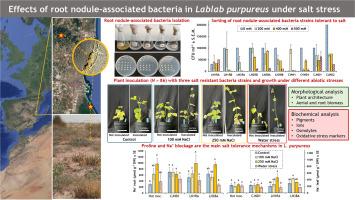紫斑拉布耐非生物胁迫及根瘤相关细菌
IF 6.8
Q1 PLANT SCIENCES
引用次数: 0
摘要
气候变化的影响对21世纪的社会构成了重大挑战。盐碱化和干旱等非生物胁迫对生物多样性构成重大威胁,并威胁到作物,导致经济损失和粮食安全问题。促进可持续农业既是应对这些挑战的一种解决办法,也是应对这些挑战的必要条件,需要评估耐压作物和鉴定有益微生物,以增强抗灾能力、土壤健康和生产力,同时减少对农用化学品的依赖。在这项研究中,我们评估了Lablab purpureus(一种未充分利用的非欧洲豆科植物,具有很高的营养潜力)对盐水和水分胁迫的耐受性。从两个地中海生态系统中分离出根瘤相关菌,选取3株耐盐菌株CJND1、LN1RA和LN3BA,研究它们与外来作物L. purpureus的互作作用及其对植物非生物抗旱性和性状的影响。我们分析了物候、生物量和根系性状、光合色素、渗透物、离子含量(Na+、Cl−、K+、Ca2+)、氧化胁迫标志物、抗氧化化合物和抗氧化酶活性。细菌产生了不同的效果。CJND1和LN3BA增加了根长,而LN3BA增加了根表面积。LN1RA提高了水分胁迫下的Cha/Chb比,促进了结瘤。总体而言,根瘤相关细菌对根系性状有积极影响。盐度降低了生物量,增加了脯氨酸水平,导致根内Na+和Ca2+积累,阻碍了Na+向地上部分的转运,而水分胁迫则激活了谷胱甘肽还原酶。我们的研究结果表明,紫脓杆菌是地中海地区一种很有前景的轻度盐胁迫作物,并揭示了植物与根瘤细菌相互作用的异质性,突出了它们的农艺学潜力。本文章由计算机程序翻译,如有差异,请以英文原文为准。

Abiotic stress tolerance and root nodule-associated bacteria in Lablab purpureus
Climate change effects pose significant challenges to 21st-century society. Abiotic stresses such as salinity and drought represent a major risk to biodiversity and threaten crops, leading to economic losses and food security concerns. Promoting sustainable agriculture is both a solution and a necessity to address these challenges, requiring the assessment of stress-tolerant crops and the identification of beneficial microorganisms to enhance resilience, soil health, and productivity while reducing agrochemical reliance. In this study, we assessed the tolerance of Lablab purpureus, an underutilised non-European legume with high nutraceutical potential, to saline and water stress. Nodule-associated bacteria were isolated from two Mediterranean ecosystems, and three salt-tolerant strains (CJND1, LN1RA and LN3BA) were selected to evaluate their interaction with the alien crop, L. purpureus, and their effects on plant abiotic stress tolerance and traits. We analysed phenological, biomass, and root traits, photosynthetic pigments, osmolytes, ion contents (Na+, Cl−, K+, Ca2+), oxidative stress markers, antioxidant compounds, and antioxidant enzyme activities. The bacteria produced heterogeneous effects. CJND1 and LN3BA promoted root length, whereas LN3BA also increased root surface area. LN1RA increased the Cha/Chb ratio and enhanced nodulation under water stress. Overall, nodule-associated bacteria positively influenced root traits. Salinity reduced biomass, increased proline levels, and led to Na+ and Ca2+ accumulation in roots while blocking Na+ translocation to aerial parts, whereas water stress activated glutathione reductase. . Our results suggest that L. purpureus is a promising crop for mild salt stress in the Mediterranean and reveal the heterogeneity of the plant and root nodule bacteria interactions, highlighting their agronomic potential.
求助全文
通过发布文献求助,成功后即可免费获取论文全文。
去求助
来源期刊

Plant Stress
PLANT SCIENCES-
CiteScore
5.20
自引率
8.00%
发文量
76
审稿时长
63 days
期刊介绍:
The journal Plant Stress deals with plant (or other photoautotrophs, such as algae, cyanobacteria and lichens) responses to abiotic and biotic stress factors that can result in limited growth and productivity. Such responses can be analyzed and described at a physiological, biochemical and molecular level. Experimental approaches/technologies aiming to improve growth and productivity with a potential for downstream validation under stress conditions will also be considered. Both fundamental and applied research manuscripts are welcome, provided that clear mechanistic hypotheses are made and descriptive approaches are avoided. In addition, high-quality review articles will also be considered, provided they follow a critical approach and stimulate thought for future research avenues.
Plant Stress welcomes high-quality manuscripts related (but not limited) to interactions between plants and:
Lack of water (drought) and excess (flooding),
Salinity stress,
Elevated temperature and/or low temperature (chilling and freezing),
Hypoxia and/or anoxia,
Mineral nutrient excess and/or deficiency,
Heavy metals and/or metalloids,
Plant priming (chemical, biological, physiological, nanomaterial, biostimulant) approaches for improved stress protection,
Viral, phytoplasma, bacterial and fungal plant-pathogen interactions.
The journal welcomes basic and applied research articles, as well as review articles and short communications. All submitted manuscripts will be subject to a thorough peer-reviewing process.
 求助内容:
求助内容: 应助结果提醒方式:
应助结果提醒方式:


